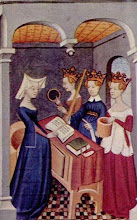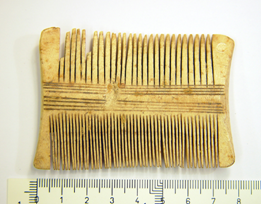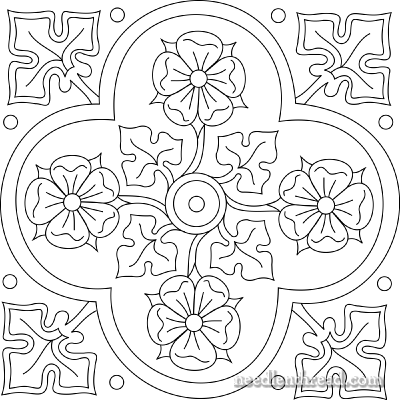Let's talk about toppers! What should I wear on my head and/or how should I try to wear my hair for this upcoming event?
I'm aiming for a 10th century generic Scandinavian look, which ought to give me a number of options. Bigger the place, the more stuff we have, right? Not exactly, no.
I decided to start my hair-dressing search with a dependable source, The Viking Answer Lady. The site creator, Gunnora, is a personal friend of mine and I've always admired her dedication to research. The page looks kind of dated, but she regularly updates the research and is absolutely willing to change her statements if she gets new information. The first thing I noticed is the collection of combs that she shows off in various museums. While many of the museum finds are ivory or bone, there is discussion of wooden combs in the same style. They looked really familiar and I knew I wanted one. I did a little poking around and discovered there are a number of shops on etsy that carry "beard combs". The same big tooth/ little tooth shape and small enough to fit in your hand but big enough to do the job. The prices range from about what I'd pay for a normal plastic comb all the way up to the super carved and personalized double digit ones.
Yes, I know I'm not going to be wearing the comb, but it's a nice place to start ( oooh, new toy!). I could make one, thanks to this good 'ible over on Instructables. But I'm not very good at wood yet. So I bought a nice hardwood comb and started using it as part of my nightly hair care routine. since it's not really safe to get a hair cut during the pandemic I've been growing my hair out for about 2 years. I had it trimmed in January of 2020, but it was roughly shoulder length at the time. Now it's gone to about the small of my back and I've been looking into ways to take care of it, so it will grow longer and so that I'm not being attacked by hair constantly and just wack it all off in a fit of pique. I found the Long Hair Community Forums and spent lots of time reading up. Wooden combs, braids, and head coverings are all hot topics of discussion there, as well as how and when to wash your hair and other useful topics.
Previously I had made a "Dublin Cap" using the information and pattern direction provided by Jennifer Thies . While the cap came out ok, I didn't look very good in it. Turns out I have a very tiny head and a close fitting cap makes that look weird. I did use a fine linen instead of silk for the cap, but that didn't change the drape very much.
A little more searching brought me to Ciar's Stitch in Time blog post on Viking head coverings. I really appreciated how she listed the Who/What/When/Where of each one of her looks. Braids! Scarves! Pointy stick buns! All this plus an interesting and interactive comment section! I exclaimed a lot while I was reading. I really recommend it.
One of the commenters mentioned the Silkeborg Museum and added a link that at one point went to an article about the Elling woman. I poked around on that website but was unable to find the article in question. My Danish is non-existent, but Google was able to translate the page for me fairly well. Elling Woman was a bog body found in 1938 in Silkeborg, Denmark. Her estimated date of death was 280 B.C.E. which makes her far older than the 10th century Norsewoman I'm trying to emulate. However, her hair was braided and twisted (and preserved) in a style that does look a bit like some of the Valkyrie figurines like that on the Osburg Cart.
So how to make the hair do that? I was very lucky to find a video by the talented Silvousplaits which has this exact hairstyle as the last one of three in a set.
She's an absolute gift to people like myself who literally can not understand written directions for hair. I need to see it happen, and then I need to see it again a few times just to make sure I can figure it out. I really enjoyed poking around on her other videos as well, since there are days I need a pinless bun or a four strand braid just for work.
It looks like I'll be trying out the Elling Woman braid, as modeled by Silvousplaits, and possibly covering it with one of Ciar's sexy scarf looks during the day. Thank you Internet for giving me some new things to do with my hair.










